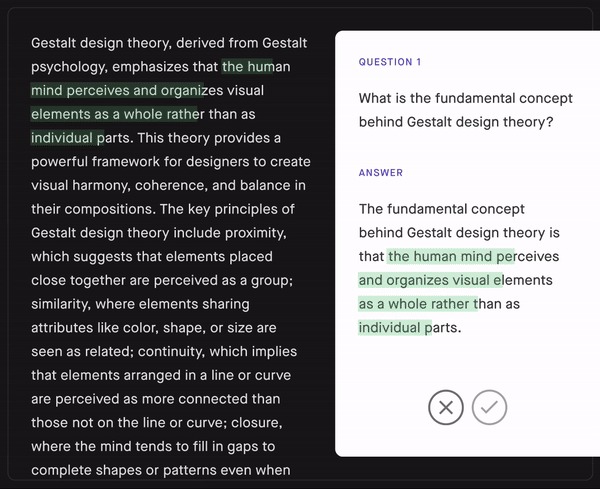AI training data is the foundation of every machine learning model, shaping how AI systems recognize patterns, make predictions, and improve over time. This guide explains the types of training data, why quality and annotation matter, and how to build reliable, ethical datasets that power accurate and trustworthy AI results.


The phrase “garbage in, garbage out” is more than a maxim; it’s a reminder of what you’ll get if you lay the wrong groundwork. Training data for AI forms the bedrock of every model, shaping how it perceives, predicts, and performs. This guide explains what AI training data is, why it matters, and how to ensure its quality from the start.
Here’s what you’ll learn:
AI training data refers to the information used to teach machine learning models and artificial intelligence systems how to recognize patterns and make predictions. This data is much like a textbook for students. If the material is clear, accurate, and complete, the “student” (your model) will learn effectively.
Training data consists of two main components: features and labels. A feature is an input variable, such as an image, sound, or text sample, while a label is the correct output or category the model should associate with that feature. Defining these correctly determines whether a model understands what it’s learning or simply memorizes patterns.
For example, to train a model to distinguish between dogs and cats, you might feed it thousands of labeled images, each tagged with the correct animal name. Over time, the model learns to identify traits such as ear shape and fur texture. The same process applies to more complex machine learning training data, such as analyzing EKG signals to detect abnormal heart rhythms or predicting manufacturing defects from sensor readings.
Once this foundation is in place, supervised fine-tuning can further refine accuracy, enabling the AI system to deliver deeper, more specific insights across different applications.

AI models are only as good as the information they’re given. Without accurate, representative, and diverse data, you’ll end up with irrelevant or false conclusions. If you’re not careful, human biases can poison your AI data quality, turning outputs into little more than echo chambers.
Human biases can unintentionally degrade your machine learning training data, turning outputs into echo chambers rather than insights. When that happens, models produce results that don’t reflect reality or your intended goals.
With a better training dataset, one that’s properly organized and labeled, you get more reliable results, which can lead to stronger, more confident decisions. If data quality is poor, it can lead to inaccurate predictions that have nothing to do with the AI's learning model.
If data quality is poor, it can lead to inaccurate predictions that have nothing to do with the model’s sophistication. Reliable, well-labeled data enables better automation, clearer forecasting, and more trustworthy outcomes across every AI use case.
Generative AI training data is broken into a few core categories. Understanding how each type is used helps you see how machine learning models power everything from voice assistants to autonomous vehicles.
Training data for AI is broken into easily recognized formats:
Labeled data refers to manually annotated data with correct answers or tags, while unlabeled data refers to raw data without annotations or tags.
Please note that it’s possible to combine both approaches. For example, training data for consumer tech might feed an AI model with user behavior data to understand how users use their devices daily. The company might start with unlabeled data to spot general patterns before classifying them in the final step of supervised learning.
Data annotation and labeling are critical for separating raw data, but they require time-consuming manual labor that can quickly eat into your budget. However, without high-quality labels, you’ll lose consistency and domain expertise if you run any type of supervised learning.
Opting for unsupervised learning may be far simpler than painstakingly combing through your train data, but it’s also a one-way ticket to questionable conclusions. Today’s professional data labeling services offer human-in-the-loop processes, helping your organization determine where to go next and why. With the right support, you can scale quality labeling for even your biggest projects.
Training data quality starts with preparation. Every step from collecting raw inputs to reviewing annotations affects how accurately your model performs.
Curating AI training data is as important for accuracy as it is for representation, which is just one reason why data labeling services are so valuable. For example, the error rate of facial recognition for light-skinned men is under 1% whereas the error rate for darker-skinned men is over a third.
If you want to scale AI training models without sacrificing quality, professional data labeling services and annotation platforms can help close the gap between raw data and reliable insights. They ensure your datasets are not only accurate but also ethically sourced and fairly representative, two qualities that directly impact performance.
Training data is the ground floor of any successful artificial or machine learning system. The more diverse and accurate the data, the more you can trust the model’s performance.
Validating your AI training data ensures each project delivers meaningful results and prevents the AI disconnect that has left many companies feeling disillusioned. With the right data annotation support, companies can trust their training data at every step.
Want to learn how Sama ensures ethical, high-quality annotation at scale? Request a consultation to learn more today!